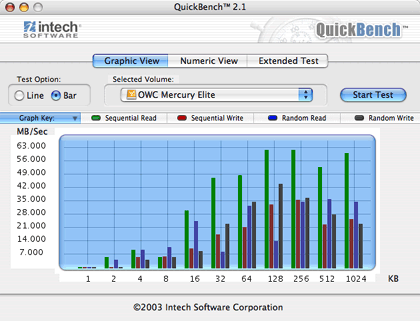Hardware Review
Mercury Elite-AL Pro RAID

Developer: Other World Computing
Price: $130–980, depending on capacity
Requirements: Mac with FireWire
Recommended: FireWire 800 and Mac OS X 10.2.8
Trial: None
Ask a non-techie what RAID is, and he’ll probably tell you it’s bug spray. That wouldn’t be entirely inaccurate, but Other World Computing (OWC) has a different idea of what RAID means.
RAID originally stood for “redundant array of inexpensive disks,” coined in an era when large-capacity hard drives were unheard of and “inexpensive” was a relative term. Bear in mind that when RAID was patented by IBM in 1978, a five-megabyte hard disk cost several thousand dollars and was approximately the size of a Centris 650. By combining several smaller hard disks into one cohesive unit, a much greater storage capacity—or speed—could be achieved, in much the same way as modern-day computing clusters such as Virginia Tech’s Terascale Computing Facility (probably better known to most readers as “System X” or, more informally, “Big Mac”). Over the years, as speed became more of a concern than price, “inexpensive” was gradually replaced by “independent,” which is now the accepted definition.
There are several different flavors, or “levels,” of RAID, most of which were outlined in the 1988 SIGMOD paper—“A Case for Redundant Arrays of Inexpensive Disks (RAID)” You can find a good explanation of the various levels of RAID at Wikipedia.

The Elite-AL is RAID 0, or “striped” RAID, which gives good speed and efficiency at the expense of reliability by distributing the data load across both drives in the array. If one of the two mechanisms fails, the whole data set will likely be lost, effectively halving the reliability of the array relative to a single external hard disk.

One caveat before we get into the meat of the review: the Elite-AL is a FireWire-only device, and folks stuck in the relative dark ages of Mac OS 10.1 or Windows 98 will find themselves with only FireWire 400 capabilities. Jaguar, Panther, and Tiger users, as well as Win 2K and XP users, will be able to utilize the entire bandwidth of FireWire 800. This is most likely to impact performance in sustained transfers of large files or other tasks where bandwidth is at a premium. If you’re thinking of running the array as your boot drive or simply as a fast external storage device, the difference between the two FireWire speeds will likely be negligible in real-world use.
OWC has long had a reputation for designing attractive external hard drive cases. The dual-drive enclosure for the Mercury Elite-AL is one of the most attractive external hard drive cases I’ve ever seen. It looks like Rick Moranis was testing one of his crazy inventions on a Power Mac G5, except this time, the results were good. (I half-expect to see an ant-size Steve Jobs crawling out of the front of the enclosure any time now.)

My biggest visual gripe is one that regular readers will have heard before: an overly bright-blue LED makes this drive enclosure extremely inhibitive of sleep. The LED isn’t as bright as that on OWC’s Mercury Elite enclosure, but with the design goal clearly to match the G5 tower as closely as possible, I’m left wondering why a white LED wasn’t chosen instead.
There’s a fan in the enclosure, but the drives run so cool under most conditions that it’s probably unnecessary (especially with the solid aluminum casing acting as a huge heat sink). Thankfully, the fan is quiet. All you hear with the enclosure powered up and running is a low-pitched whoosh that completely fades into background noise after a few minutes. Kudos to OWC’s acoustic engineers for solving what has proven to be a serious problem in the past with many external devices.

The heart of the array is its Oxford 912 chip set, a FireWire 800 bridge chip that provides a FireWire 800 interface (IEEE 1394b) for IDE devices in addition to hardware RAID 0 capabilities. The bare dual-drive enclosure/controller/power supply is available for $130 for the do-it-yourselfer, but most folks will probably be well served by purchasing the pre-assembled units with matching 7200 RPM Seagate Barracuda drives.
The Barracudas are solid performers with a great reputation, and the capacity of the array is limited only by how much money you can budget. The mid-range 400 GB ($380) unit is what I’m reviewing here, but capacities of up to one terabyte ($980) are available. As previously mentioned, RAID 0 effectively halves the reliability of the drives used in a two-drive array, so it’s important to buy a high-quality drive mechanism if you’re thinking of building your own to save money.
First impressions of the performance of the array are, well, impressive. Video playback on a 1.5 GHz PowerBook is never choppy, even with full-screen high-bandwidth content. With this RAID hooked up, it’s clear that the limiting factor of the PowerBook’s video playback capabilities is the internal hard disk rather than the CPU. With the compact size and fairly good portability of the Elite-AL array, mobile audio/video professionals will have another tool in their arsenals. It’s easy to envision a luggable production studio with most of the heavy disk I/O handled by the FireWire 800 bus.

The Elite-AL is about 2–3 times the speed of the internal drive on the PowerBook.
At just under $1 per gigabyte, the Elite-AL RAIDs aren’t the greatest deal out there in terms of sheer storage capacity for a given price, but you’d be hard-pressed to find this speed in a standard (non-RAID) external drive, especially with a top-brand mechanism in the case. Second-tier brands are all over the place for dirt-cheap prices, but I’ve known lots of people who had serious problems with failing mechanisms from vendors other than IBM and Seagate. OWC looks to have another solid product on its hands with the Mercury Elite-AL.
Reader Comments (1)
Add A Comment